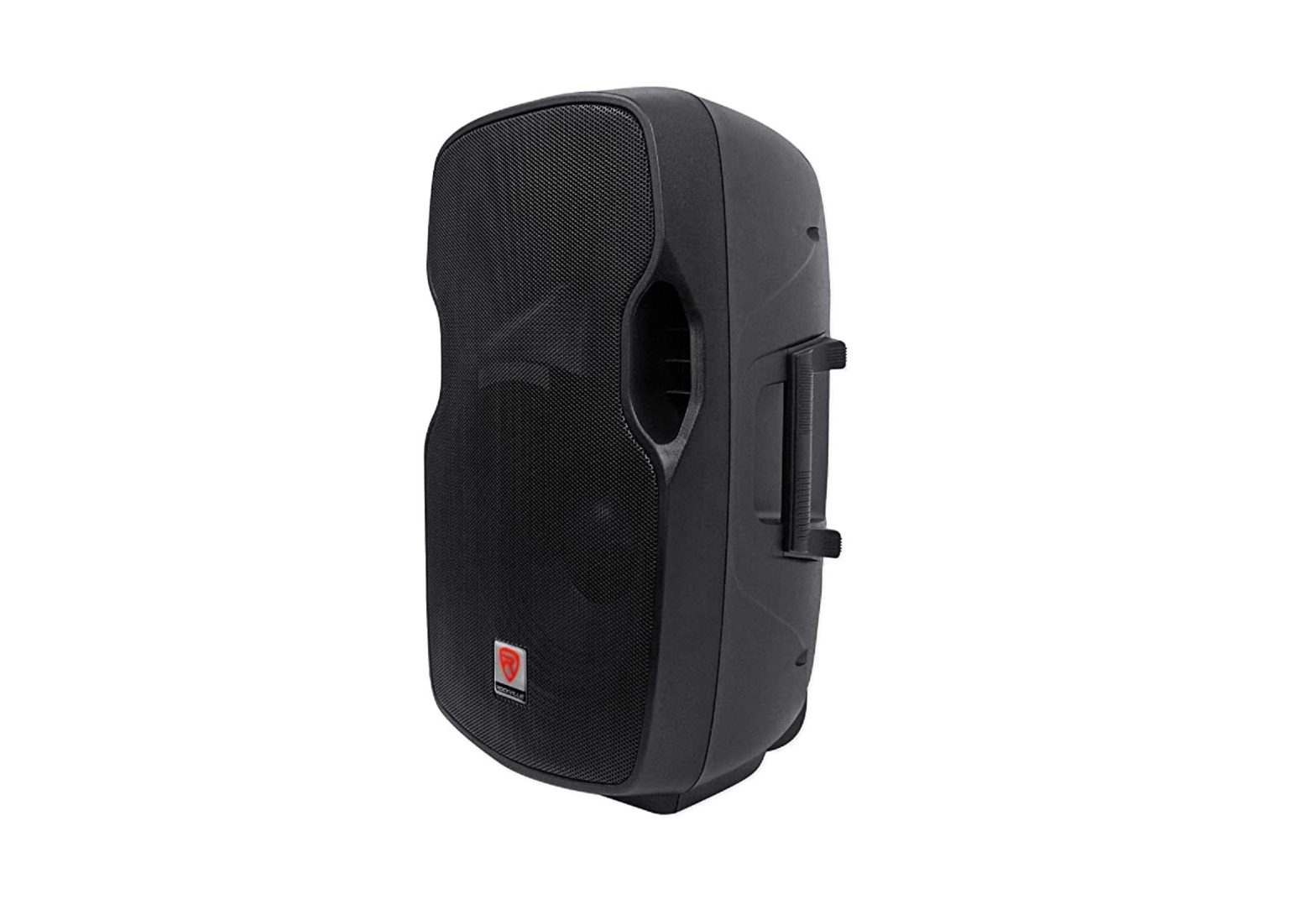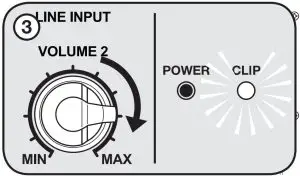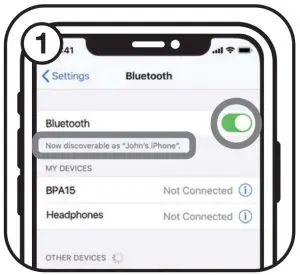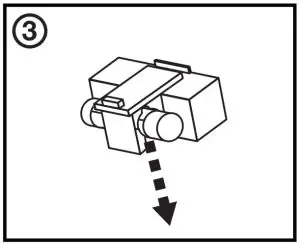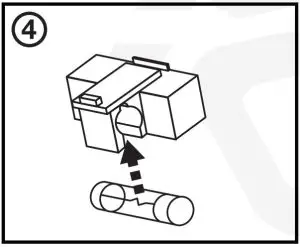ROCKVILLE BPA15 15˝ Active DJ PA Speaker with Bluetooth Owner’s Manual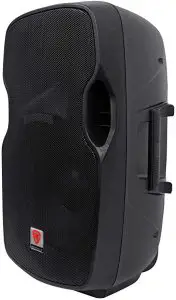
Thank you for purchasing this Rockville BPA15 15˝ Active DJ/PA Speaker with Bluetooth.Please read this installation guide carefully for proper use of your BPA15 speaker. Should you need assistance, please call our technical help line at 1-646-758-0144, Monday through Friday, 9am to 5pm EST.
IMPORTANT SAFETY INSTRUCTIONS
![]() CAUTION
CAUTION
 RISK OF ELECTRIC SHOCK
RISK OF ELECTRIC SHOCK- DO NOT OPEN
- To reduce risk of electric shock, never open the unit. There are no user-serviceable parts; refer service to an authorized Rockville service center.
- Do not expose this unit to any kind of moisture.
- Please ensure that the unit is situated in a properly ventilated area.
- Make sure the unit is placed on a level and stable surface.
- This unit can operate with either 110V or 220V. See page 10 for instructions.
Setting Up Your BPA Professional Sound System
Your BPA is set up to produce the full spectrum of sound from its woofer and tweeter horn combination. The lower frequencies seek out the floor of the room they are playing and travel along the floor and walls. The tweeter horn is more directional. Hence when setting up your system its more important to make sure that the tweeter horns are not blocked by any furniture and are located / aimed at ear level to the listening audience. Woofer aiming is not as critical as explained previously due to the nature of the woofer sounds able to travel through various paths even when blocked.
It is therefore recommended that when setting up your system you set up your speakers on speaker stands, such as the Rockville model RVSS-2 (not included) so that the tweeter sounds will radiate above the listening crowd. This will guarantee optimum sound dispersion and achieve clear vocal sound reproduction.
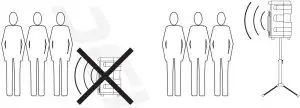
How To Avoid Irritating Feedback
The placement of your microphone is critical in avoiding feedback through your BPA system. Never set up your microphone in front of the speaker. Always set up your microphone behind the speaker. When approaching the speaker to make any adjustments, we recommend approaching the speaker from the rear and not walking directly towards the front of the speaker.
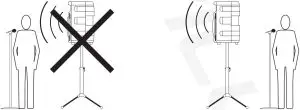
Setting Level Control
It is best practice to set your input volume (gains) in this manner:
- Unplug all inputs except for the one you wish to set the gain for. In this instance, the LINE INPUT RCA jacks.

- Set the line-level input device volume (smart phone, tablet, MP3 player, etc.) 60%.

- Slowly turn up the LINE INPUT volume control. As soon as the clip indicator LED goes on or you hear any distortion – turn it down one or two notches.

PLEASE NOTE:
- Because mixers feature two volume controls (channel and master), when connecting one via the XLR line in port, the procedure is slightly different. Set the BPA’s LINE INPUT volume to 50% and set the mixer master volume to 50%. Make the adjustments in step 3 on the mixer channel level control. If after making these adjustments the signal still isn’t strong enough, you can additionally boost the signal by turning up the BPA’s LINE INPUT control.
- When adjusting the MIC INPUT volume control, you must speak into the microphone and adjust the control as needed. This is because adjustments to the mic input are a matter of mic volume in relation to the music volume and not necessarily a clipping issue.
Microphone Presentations
Your BPA features balanced microphone input via XLR or ¼˝ TRS inputs.
- Switch OFF your BPA.
- Plug your microphone into the ¼˝ TRS or XLR jack. NEVER USE BOTH PORTS AT ONCE.
- Switch ON your BPA.
- Refer to the “Setting Level Controls” section of this manual for instructions o how to properly adjust the input volume (gains)
Always stand behind the BPA when making your microphone adjustments to avoid feedback distortion.
Line Input
You can use the LINE INPUT XLR input to connect a mixer. Use the RCA and 3.5mm AUX inputs to connect an additional stereo signal source such as a smart phone, tablet, MP3 player, CD player, etc.
- Switch OFF your BPA.
- Connect the input source unit to the 3.5mm input, RCA jacks, or XLR input. ONLY USE ONE INPUT AT A TIME.
- Switch ON your BPA.
- Refer to the “Setting Level Controls” section of this manual for instructions on how to properly adjust the input volume (gains).
Public Address/Concert Mixer Setup
When setting up for larger venues, a passive mixing console becomes a critical piece of equipment for appropriately mixing signals from multiple inputs such as singers, speakers, effects devices, musicians, and of course allows for multiple speaker utilization.
- Switch OFF your BPA.
- Connect the left main output of the mixer to the LINE INPUT XLR port of your left BPAunit. Connect the right main output of the mixer to the LINE INPUT XLR port of your right BPA unit.
- Switch ON your BPA.
- Refer to the “Setting Level Controls” section of this manual for instructions on how to properly adjust the input volume (gains).
ATTENTION: Please be sure to use a passive mixer.
Bluetooth Pairing
To connect your iPod, iPhone, MP3 player, Android phone or any other Bluetooth capable device follow the steps listed below.
- Turn on the Bluetooth feature on your device and ensure that it is discoverable.

- Switch ON your BPA and press the MODE button until it is in BT mode. TheLCD display will read “bt”.

- Look for “BPA15” on the list of available devices and select it.

- If you have problems pairing your device please check the troubleshooting guide.
USB/SD Input
For USB/SD playback insert an SD card or USB flash drive and the unit will automatically begin playback. Please note, when an SD card or USB flash drive is inserted, it will override all other input modes. If you switch to another mode and wish to return to USB/SD mode, simply press the MODE button until the USB/SD LED is illuminated.
FM Radio
- Press the MODE button until the LCD display shows frequency digits.
- Press and hold the
 button to scan for and save available FM stations.
button to scan for and save available FM stations. - Use the
 and
and  buttons to select stations.
buttons to select stations.
Line Out Balanced Connection
The XLR line output port allows you to send the amplifier signal to a powered subwoofer, another powered speaker, or an amp, which will, in turn, power other speakers. Simply connect the output device to the XLR port labeled LINE OUT using an XLR to XLR or an XLR cable to share the signal. We recommend you use high quality cables such as Rockville’s RCXFM20E-B XLR to XLR cable or RCXMB20-B XLR to ¼˝ TRS cable.
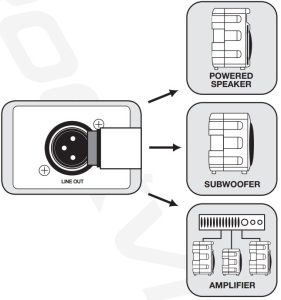
Installation
The XLR inputs and outputs of this BPA unit are fully balanced. To maximize interference compensation, we recommend establishing balanced connections to other equipment whenever possible.
Balanced use with XLR connectors
- 1 = ground/shield input output
- 2 = hot (+ve)
- 3 = cold (-ve)
For unbalanced use, pin 1 and pin 3 have to be bridged
- input

- output

Speaker Mounting Point
The BPA15 features a fly point located at the rear/bottom of the speaker. To mount the speaker, simply loosen the lock knob on the pole mount located at the back of the unit near the bottom (fig. a). Carefully lift the speaker and place it onto the stand or flypole (fig. b).Now tighten the the lock knob on the pole mount (fig. c).

Functions

- MODE: Push to switch between modes (USB/SD/BT/FM)
- STOP: Stop all playback
- MUTE
- PREV/
 : In USB/SD/BT mode press for previous track, press and hold to rewind. In FM mode press for previous station.NEXT/
: In USB/SD/BT mode press for previous track, press and hold to rewind. In FM mode press for previous station.NEXT/  : In USB/SD/BT mode press for next track, press and hold to fast forward. In FM mode press for next station.
: In USB/SD/BT mode press for next track, press and hold to fast forward. In FM mode press for next station. - Play/Pause
- VOL -/ and VOL +/
- EQ: Press to cycle through preset EQs – Normal, Rock,Pop, Classic, Jazz, & Country
- Number pad: In USB/SD mode use to select track numbers. In FM mode, use to select preset stations
- A. To select tracks in the one hundreds, press the 100+ button and then the proceeding digits. For example, to reach track 125, press 100+ then 2 and then 5.
- B. To select tracks in the two hundreds, press the 200+ button and then the proceeding digits. For example, to reach track 225, press 200+ then 2 and then 5.

- LED screen
- SD input
- USB input
- Mode control button: Push to switch between modes (USB/SD/BT/FM)
- MP3 Controls:
- Play/Pause
- Stop
- Repeat
- Rewind: In USB/SD/BT mode press for previous track, press and hold to rewind. In FM mode press for previous station.
- Fast Forward: In USB/SD/BT mode press for next track, press and hold to fast for- ward. In FM mode press for next station.
- Line Input/Auxiliary Input volume control
- Mic Input volume control
- 1/4˝ Balanced TRS Mic input
- 3.5mm auxiliary input
- Balanced XLR Mic input
- Balanced XLR Line input
- Balanced XLR line out
- Treble control, -12dB to +12dB
- RCA line input
- Bass control, -12dB to +12dB
- Power/Clip LED indicators
- MP3 volume control
- Power switch
- IEC AC power socket
- Fuse compartment. Fuse rating: 250V/5A
Fuse Replacement Diagram
- Use a screwdriver to release the fuse holder.

- Remove the fuse holder.

- Remove the fuse.

- Replace the fuse.

- Re-insert the fuse holder.

How to Switch Voltage
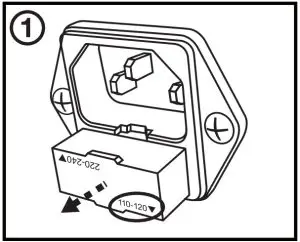

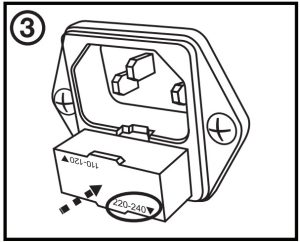
Specifications
- 200 Watts RMS/400 Watts Program Power/800 Watts Peak
- Frequency Response: 20Hz – 20KHz
- Maximum SPL @1w/1m: 128dB peak/125dB continuous
Features
- Bluetooth range: 32 feet
- USB/SD digital MP3 music player. Accepted formats: MP3, WMA, WAV
- Wireless remote control
- Built-in LED screen
- High-power 2-way pro sound reinforcement speaker system for live sound and play- back applications.
- Compact and light-weight system delivers distortion-free sound even at extreme SPL.
- Linear Class AB amplifier technology ensures high-power, transparent sonic performance.
- Internal switch-mode power supply for low-distortion audio with superior transient response.
- Built-in bass and treble equalization processor for ultimate system control and speaker protection.
- High-power long-throw 15˝ woofer with 2.5˝ KSV voice coil provides incredibly deep bass and acoustic power.
- State-of-the-art 1˝ pure titanium-diaphragm compression driver.
- Ultra-wide dispersion, 45° large-format horizontal wave guide horn molded directly into cabinet.
- Built-in high-quality crossover to filter out unwanted frequencies.
- Ultra-low-noise Mic input via XLR & ¼˝ TRS stereo jacks with volume control.
- Line RCA, XLR, and 3.5mm input with independent volume control.
- Additional XLR line output to connect multiple speakers or a mixer.
- Stand mounting with 35mm pole socket.
- Flyable
- High-quality components and exceptionally rugged high-impact ABS construction.
- Amplifier clip limit & power LED indicators
- Built-in FM radio with 10 presets and US/European tuning.
- 110/220 Volt switchable with external user serviceable fusing.
- Fuse rating: 250V/5A
- Item actual dimensions: 16.15˝ (L) x 14.18˝ (W) x 27.19˝ (H)
- Item actual weight: 33LBS
Troubleshooting
| PROBLEM | SOLUTION |
| No power |
|
| No sound/ distorted sound |
|
| Buzzing sound | Make sure you are using a proper cable. For 1/4″ cables, there are 3 types: instrument. TS (unbalanced), and TRS (balanced). Check the requirements of the connected gear and the input of the speaker and make sure you are using the appropriate cable. |
| Mic feedback | Point the mics away from the speaker. Make sure the mics are behind the speaker, not in front of it. |
| Poor Mic sound |
|
| Bluetooth pairing fails |
|
| No SD or USB playback |
|
FEDERAL COMMUNICATIONS COMMISSION COMPLIANCE INFORMATION
Responsible party name: Rockville
Address: 600 Bayview Ave. Entrance A Inwood, NY 11096
Hereby declares that the product(s) BPA15 15˝ pro audio speakers comply with FCC rules as mentioned in the following paragraph:
This device complies with Part 15 of the FCC rules. Operation is subject to the following two conditions: (1) this device may not cause harmful interference, and (2) this device must accept any interference received, including interference that may cause undesired operation.
Note: This equipment has been tested and found to comply with the limits for a Class B digital device, pursuant to Part 15 of the FCC rules. These limits are designed to provide reasonable protection against harmful interference in a residential installation. This equipment generates, uses, and can radiate radio frequency energy and, if not installed and used in accordance with the instructions, may cause harmful interference to radio communications. However, there is no guarantee that interference will not occur in a particular installation. If this equipment does cause harmful interference to radio or television reception, which can be determined by turning the equipment off and on, the user is encouraged to try to correct the interference by one or more of the following measures:
- Reorient or relocate the receiving antenna.
- Increase the separation between the equipment and receiver.
- Connect the equipment to an outlet on a circuit different from that to which the receiver is connected.
- Consult the dealer or an experienced radio/TV technician for help.

References
[xyz-ips snippet=”download-snippet”]

